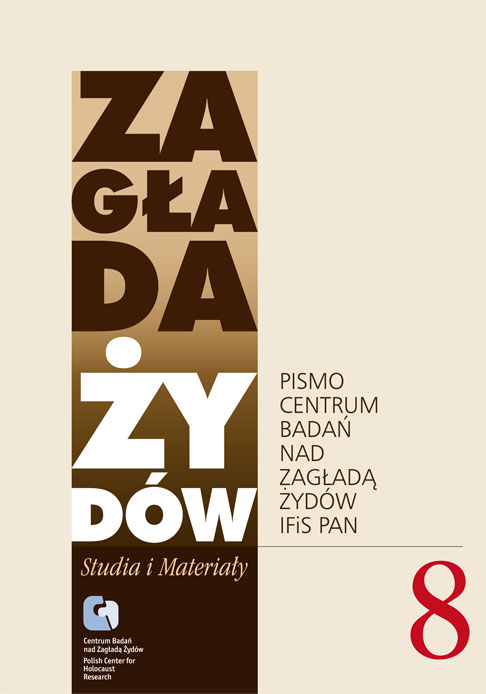O tym, co minęło, lecz nie zostało zapomniane: Badania archeologiczne na terenie byłego obozu zagłady w Treblince
Zagłada Żydów. Studia i Materiały, Nr 8 (2012), Strony: 83-118
Data zgłoszenia: 2020-10-27Data publikacji: 2012-12-02
 https://doi.org/10.32927/ZZSiM.628
https://doi.org/10.32927/ZZSiM.628
Abstrakt
Public impression of the Holocaust is unquestionably centred on knowledge about, and the image of, Auschwitz-Birkenau – the gas chambers, the crematoria, the systematic and industrialized killing of victims. Conversely, knowledge of the former extermination camp at Treblinka, which stands in stark contrast in terms of the visible evidence that survives pertaining to it, is less embedded in general public consciousness. As this paper argues, the contrasting level of knowledge about Auschwitz- Birkenau and Treblinka is centred upon the belief that physical evidence of the camps only survives when it is visible and above-ground. The perception of Treblinka as having been “destroyed” by the Nazis, and the belief that the bodies of all of the victims were cremated without trace, has resulted in a lack of investigation aimed at answering questions about the extent and nature of the camp, and the locations of mass graves and cremation pits. This paper discusses the evidence that demonstrates that traces of the camp do survive. It outlines how archival research and non-invasive archaeological survey has been used to re-evaluate the physical evidence pertaining to Treblinka in a way that respects Jewish Halacha Law. As well as facilitating spatial and temporal analysis of the former extermination camp, this survey has also revealed information about the cultural memory.
Słowa kluczowe
Treblinka , archeologia Zagłady , obóz zagłady , dowody rzeczowe , halacha
Licencja
Prawa autorskie (c) 2012 Autor&"Zagłada Żydów. Studia i Materiały"

Utwór dostępny jest na licencji Creative Commons Uznanie autorstwa 4.0 Międzynarodowe.
https://creativecommons.org/licenses/by/4.0
Czasopismo publikowane jest w standardzie Diamond Open Access na licencji CC-BY-4.0 Deed - Uznanie autorstwa 4.0 Międzynarodowa - Creative Commons
Inne teksty tego samego autora
- Caroline Sturdy Colls, Gone but not Forgotten: Archaeological approaches to the site of the former Treblinka Extermination Camp in Poland , Zagłada Żydów. Studia i Materiały: Nr Holocaust Studies and Materials (2013)
Podobne artykuły
- Tomasz Żukowski, Jan Borowicz, Pamięć perwersyjna. Pozycje polskiego świadka Zagłady [Tomasz Żukowski] , Zagłada Żydów. Studia i Materiały: Nr 17 (2021)
- Bartłomiej Krupa, Tomasz Żukowski, Pod presją. Co mówią o Zagładzie ci, którym odbieramy głos [Bartłomiej Krupa] , Zagłada Żydów. Studia i Materiały: Nr 17 (2021)
- Artur Żmijewski, Fotografie z Berka , Zagłada Żydów. Studia i Materiały: Nr 17 (2021)
- Piotr Forecki, Książki pod specjalnym nadzorem [Mirosław Tryczyk, Miasta śmierci i Drzazga; Paweł Piotr Reszka, Płuczki] , Zagłada Żydów. Studia i Materiały: Nr 17 (2021)
- Katarzyna Kuczyńska-Koschany, Zbyt mała, by być (tak) dużą. Rozważania na marginesie polskiej edycji krytycznej Mein Kampf Adolfa Hitlera , Zagłada Żydów. Studia i Materiały: Nr 17 (2021)
- Krzysztof Rybak, Zagłada (nie) dla dzieci. Nadużycia w polskiej literaturze dziecięcej XXI wieku , Zagłada Żydów. Studia i Materiały: Nr 17 (2021)
- Justyna Kowalska-Leder, „Zawołani po imieniu”, czyli Krzywda i Sprawiedliwość , Zagłada Żydów. Studia i Materiały: Nr 18 (2022)
- Maria Ferenc, „Zrozumiałe, że zostajemy na miejscu”. Działacze chalucowi wobec perspektywy ucieczki z okupowanej Polski , Zagłada Żydów. Studia i Materiały: Nr 19 (2023)
- Katarzyna Tałuć, Krzysztof Rybak, Obrazowanie Zagłady. Narracje holokaustowe w polskiej literaturze XXI wieku dla dzieci i młodzieży , Zagłada Żydów. Studia i Materiały: Nr 20 (2024)
- Anna Wylegała, Niezauważony potencjał? Historia mówiona w polskich badaniach nad Zagładą , Zagłada Żydów. Studia i Materiały: Nr 20 (2024)
<< < 1 2 3 4 5 6 7 8 9 10 11 12 13 14 15 16 17 18 19 20 21 22 23 24 25 26 27 28 29 30 31 32 33 34 35 36 37 38 39 40 41 42 > >>
Możesz również Rozpocznij zaawansowane wyszukiwanie podobieństw dla tego artykułu.
 English
English
 Język Polski
Język Polski



 https://orcid.org/0000-0003-2942-6219
https://orcid.org/0000-0003-2942-6219

